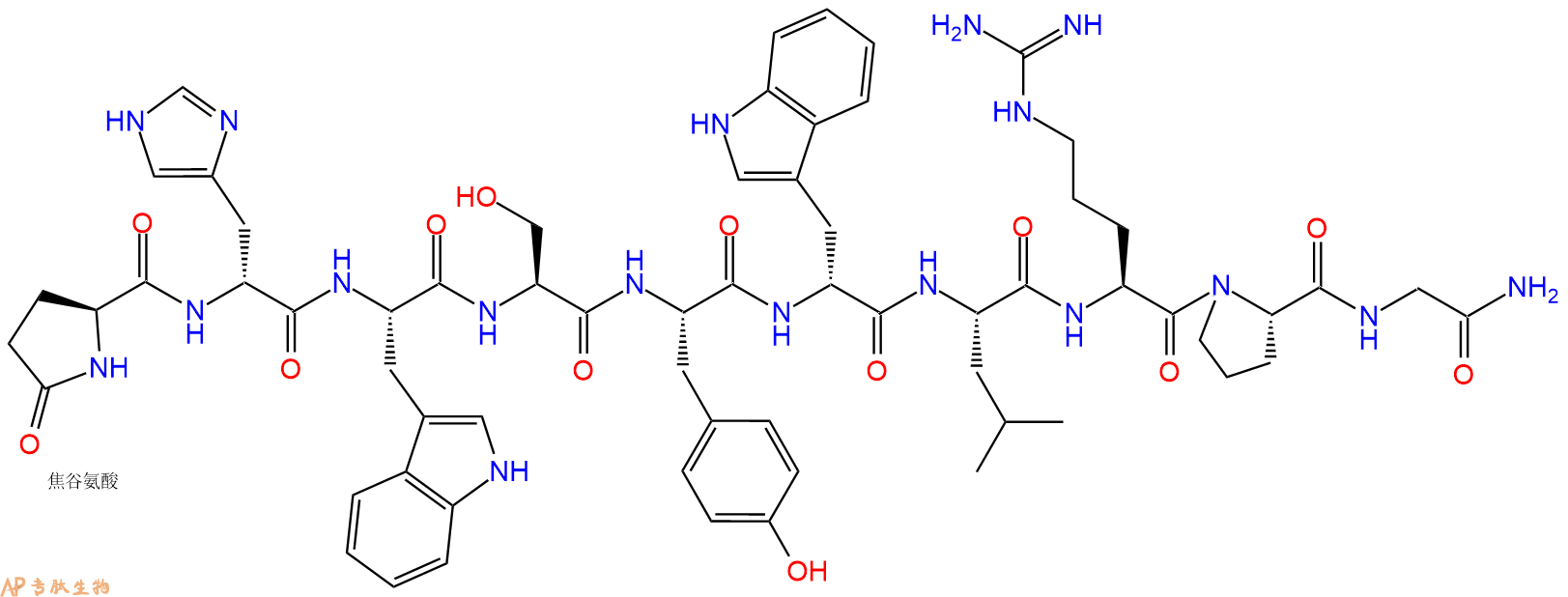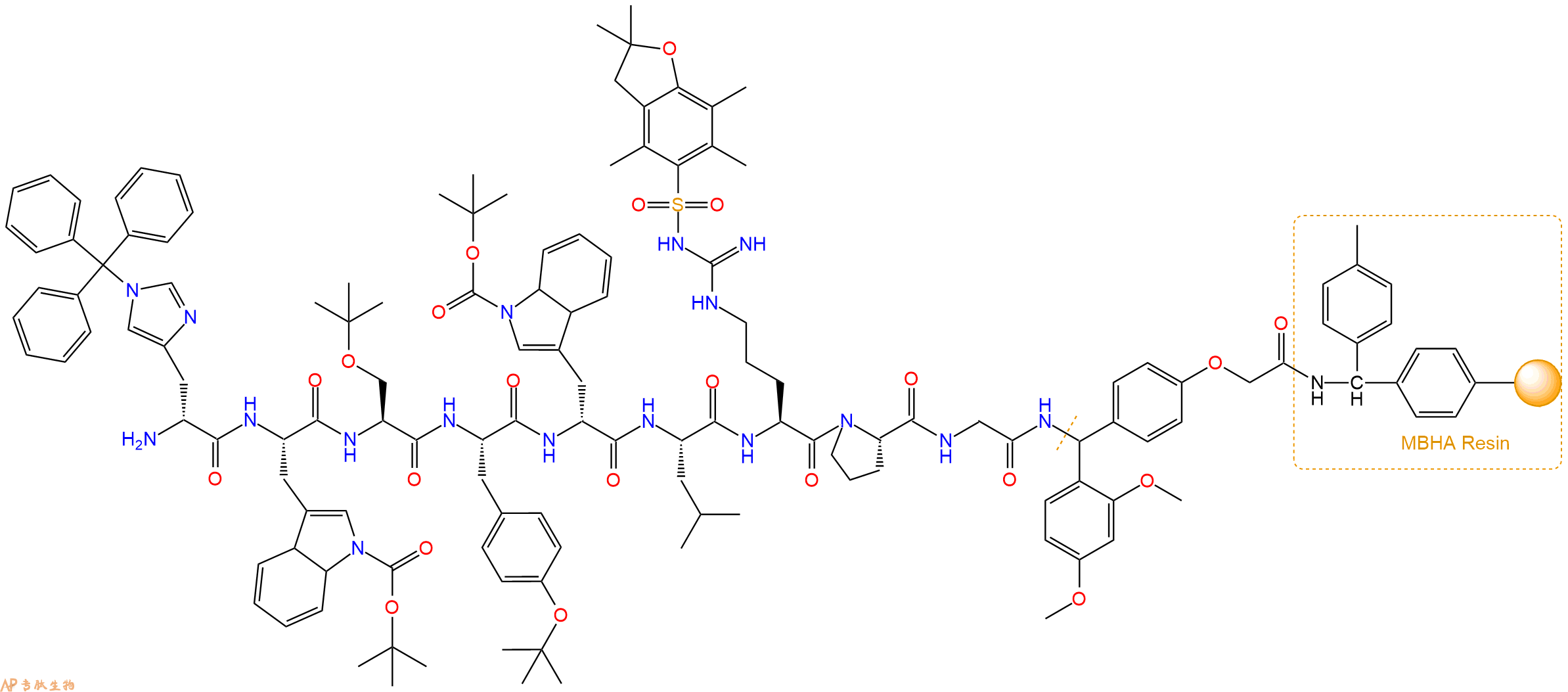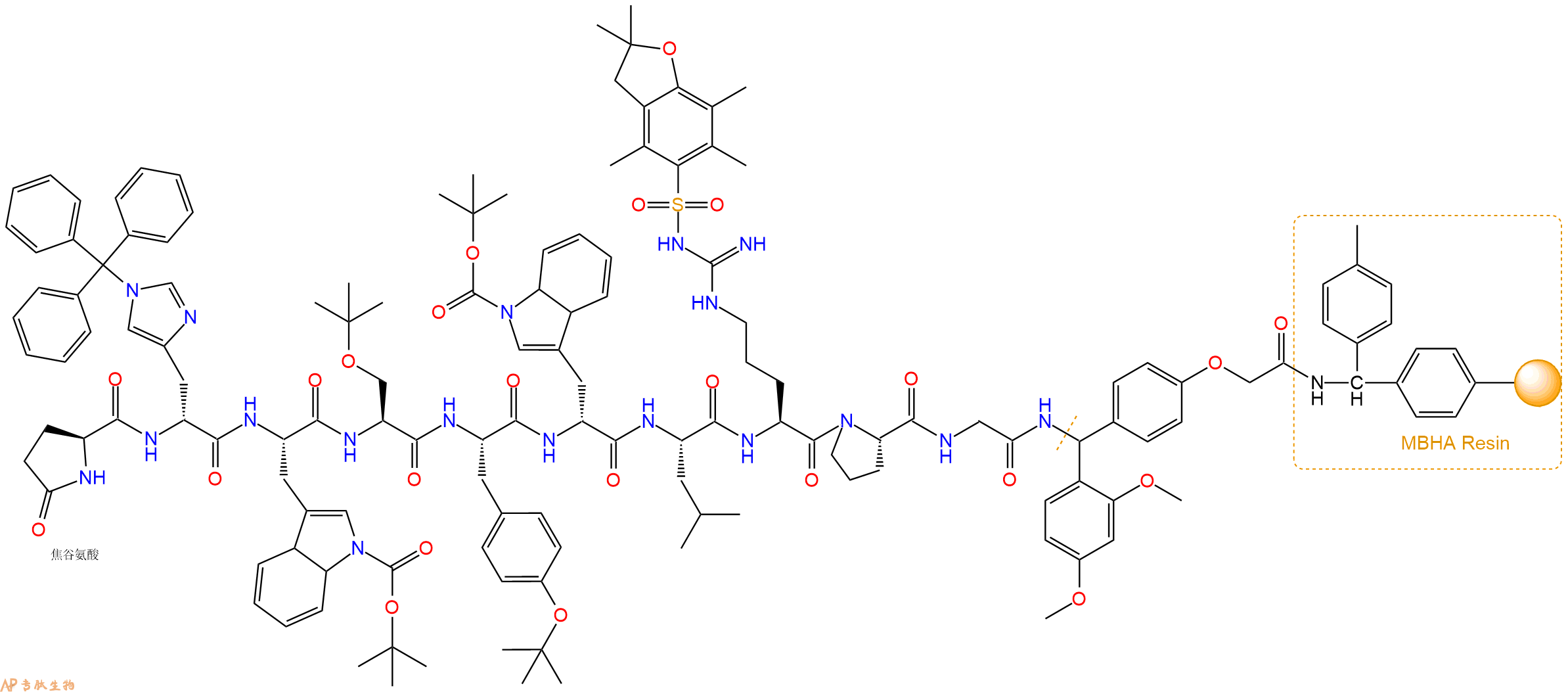400-998-5282
专注多肽 服务科研
400-998-5282
专注多肽 服务科研

(D-His2,D-Trp6)-LHRH是一种多肽,能够由多肽筛选发现。多肽筛选是一种主要通过免疫测定法而集合活性多肽的研究工具。可用于蛋白互作、功能分析,抗原表位筛选以及活性分子的开发与研究。
编号:200214
CAS号:321709-34-6
单字母:Pyr-hWSYwLRPG-CONH2
| 编号: | 200214 |
| 中文名称: | 黄体生成素释放激素(D-His²,D-Trp⁶)-LHRH |
| 英文名: | (D-His²,D-Trp⁶)-LHRH |
| 英文同义词: | (D-His2,D-Trp6)-LHRH |
| CAS号: | 321709-34-6 |
| 单字母: | Pyr-hWSYwLRPG-CONH2 |
| 三字母: | Pyr 焦谷氨酸(Glp、pGlu、Pyr)是一种在蛋白质N端位置发现的蛋白质生成氨基酸。它是由N端谷氨酸残基环化形成内酰胺而产生的。 -DHisD型组氨酸 -TrpL-色氨酸:tryptophan[e]。系统命名为(2S)-氨基-3-(3-吲哚基)丙酸。是编码氨基酸,哺乳动物的必需氨基酸。符号:W,Trp。某些抗菌素中含有 D-色氨酸。 -SerL-丝氨酸:serine。系统命名为(2S)-氨基-3-羟基丙酸。是编码氨基酸。因可从蚕丝中获得而得名。符号:S,Ser。在丝原蛋白及某些抗菌素中含有 D-丝氨酸。 -TyrL-酪氨酸:tyrosine。系统命名为(2S)-氨基-3-(4-羟基苯基)丙酸。是编码氨基酸。符号:Y,Tyr。 -DTrpD型色氨酸 -LeuL-亮氨酸:leucine。系统命名为(2S)-氨基-4-甲基戊酸。是编码氨基酸。是哺乳动物的必需氨基酸。符号:L,Leu。 -ArgL-精氨酸:arginine。系统命名为(2S)-氨基-5-胍基戊酸。在生理条件下带正电荷,为编码氨基酸。是幼小哺乳动物的必需氨基酸。符号:R,Arg。 -ProL-脯氨酸:proline。系统命名为吡咯烷-(2S)-羧酸。为亚氨基酸。是编码氨基酸。在肽链中有特殊作用,如易形成顺式的肽键等。符号:P,Pro。 -Gly甘氨酸:glycine。系统命名为 2-氨基乙酸。是编码氨基酸中没有旋光性的最简单的氨基酸,因具有甜味而得名。符号:G,Gly。 -CONH2C端酰胺化 |
| 氨基酸个数: | 9 |
| 分子式: | C64H82N18O13 |
| 平均分子量: | 1311.45 |
| 精确分子量: | 1310.63 |
| 等电点(PI): | - |
| pH=7.0时的净电荷数: | 2.24 |
| 平均亲水性: | -1.3142857142857 |
| 疏水性值: | -1.04 |
| 消光系数: | 12490 |
| 来源: | 人工化学合成,仅限科学研究使用,不得用于人体。 |
| 储存条件: | 负80℃至负20℃ |
| 标签: | 促黄体生成激素释放激素(LHRH) D型氨基酸肽 垂体和下丘脑激素 |
(D-His2,D-Trp6)-LHRH是一种多肽,能够由多肽筛选发现。多肽筛选是一种主要通过免疫测定法而集合活性多肽的研究工具。可用于蛋白互作、功能分析,抗原表位筛选以及活性分子的开发与研究。
促黄体生成激素释放激素(LHRH)的定义
黄体生成素释放激素(LHRH),也称为促性腺激素释放激素(GnRH)或黄体生成素释放因子(LRF),是一种下丘脑神经肽,作用于垂体,刺激黄体生成素(LH)和卵泡刺激素(FSH)的释放。
Luteinizing hormone-releasing hormone (LHRH), also known as Gonadotropin-Releasing Hormone (GnRH) or Luteinizing Hormone-Releasing Factor (LRF) is a hypothalamic neuropeptide which acts on the pituitary to stimulate the release of luteinizing hormone (LH) and follicle-stimulating hormone (FSH).
促黄体生成激素释放激素(LHRH)的发现
LHRH于1977年首次由两位诺贝尔奖获得者Guillemin和Schally组成。该肽的垂体形式是更大的十肽家族的一部分,是第一个在哺乳动物中发现和表征的肽。在广泛的进化分类群中发现了哺乳动物和非哺乳动物物种中的多个LHRHs(迄今已鉴定出20多个LHRHs),导致了基于物种的命名法,每个LHRHs都是首次发现的【1】。
LHRH was first characterized by the groups of two Nobel Laureates Guillemin and Schally in 1977. The hypophysiotropic form of the peptide is part of a larger family of decapeptides and was the first to be discovered and characterized in mammals. The discovery of multiple LHRHs in mammalian and non-mammalian species across a wide evolutionary taxa [over 20 LHRHs identified to date] has resulted in a nomenclature based on the species each of the LHRHs was first discovered 【1】.
促黄体生成激素释放激素(LHRH)的结构特征
LHRH作为促激素从mRNA翻译而来,随后在其释放之前在分泌囊泡中转化为成熟的十肽(pGlu-His-Trp-Ser-Tyr-Gly-Leu-Arg-pro-Gly-NH2)【2】。在其分泌之后,LHRH可以被可溶性肽酶进一步切割以降解,转化或转化【3】。
LHRH is translated from the mRNA as a pro-hormone, which is subsequently converted to the mature decapeptide (pGlu-His- Trp-Ser-Tyr-Gly-Leu-Arg-Pro-Gly-NH2) in secretory vesicles prior to its release【2】. Subsequent to its secretion, LHRH may be further cleaved by soluble peptidases for the purposes of degrading, converting, or transforming【3】.
促黄体生成激素释放激素(LHRH)的作用机制
LHRH的作用是由垂体促性腺激素上的高亲和力G蛋白偶联LHRH受体(LHRH-R)介导的。在人类和大多数脊椎动物中,大脑和外周组织中存在两种形式的LHRH,LHRH-I和LHRH-II。此外,LHRH-I的加工肽LHRH-(1-5)似乎也具有与其亲本活性相反的生物活性。人们对LHRH-I和LHRH-II及其同源受体作为设计治疗生殖系统癌症的靶点产生了极大的兴趣。LHRH-I由锌金属内肽酶EC 3.4.24.15(EP24.15)加工,该酶在十肽(Tyr5-Gly6)的第五和第六个键处切割激素,形成LHRH-(1-5)。LHRH基因表达的自动调节也可以通过其加工肽LHRH-(1-5)介导。LHRH-(1-5)可能通过另一种LHRH受体(例如LHRH-RII)起作用。这是合理的,因为LHRH-(1-5)与至少9种LHRH-I形式共享前4个氨基酸。LHRH-(1-5)与其亲本肽LHRH-I具有相反的作用,这可能有助于解释LHRH-I类似物的作用之间缺乏相关性,LHRH-I类似物在垂体水平上表现为拮抗剂,但在许多癌症中导致激动剂样抗增殖作用【4,5】。
The effects of LHRH are mediated by high-affinity G protein-coupled LHRH-receptor (LHRH-R) on pituitary gonadotropes. In humans and most vertebrates, there are two forms of LHRHs, LHRH-I and LHRH-II that exist in the brain and in peripheral tissues. Furthermore, the processed peptide of LHRH-I, LHRH-(1–5), appears also to have biological activities that are in contrast to its parent activities. Enormous interest has been focused on LHRH-I and LHRH-II and their cognate receptors as targets for designing therapies to treat cancers of the reproductive system. LHRH-I is processed by a zinc metalloendopeptidase EC 3.4.24.15 (EP24.15) that cleaves the hormone at the fifth and sixth bond of the decapeptide (Tyr5-Gly6) to form LHRH-(1–5). Autoregulation of LHRH gene expression can also be mediated by its processed peptide, LHRH-(1–5). LHRH-(1–5) may act through one of the alternative LHRH receptors, such as the LHRH-RII. This is plausible since LHRH-(1–5) share the first 4 amino acids with at least 9 LHRH-I forms. LHRH-(1–5) have contrasting effects from its parent peptide, LHRH-I, could help explain the lack of correlation between the action of LHRH-I analogs that behave as antagonists at the pituitary level but result in agonist-like anti-proliferative effects in many cancers【4,5】
促黄体生成激素释放激素(LHRH)的功能
作为生长调节因子:LHRH可能在生殖系统肿瘤中起生长调节因子的作用。LHRH和LHRH受体(LHRH-Rs)在人类黑色素瘤细胞中表达,LHRH-Rs在超过50%的人类乳腺癌中被发现【6】。
As growth modulatory factor: LHRH may act as a growth modulatory factor in tumors of the reproductive system. LHRH and LHRH receptors (LHRH-Rs) are expressed in human melanoma cells and LHRH-Rs are found in greater than 50% of human breast cancers 【6】.
对卵巢的作用:LHRH以脉冲形式释放并触发促性腺激素的产生,促性腺激素刺激卵巢的生长和卵子的释放。这一事实已通过实验得到最好的说明,其中十肽的作用已被免疫中和或受体拮抗剂治疗所阻断,这总是导致促性腺激素分泌停止或减少,性腺功能破坏和不育。突变的非LHRH产生小鼠的不育和与LHRH功能不全相关的人类不育也清楚地证明了LHRH神经分泌不适当或不足的生殖后果【6】。在大鼠中,在发情前期施用LHRH拮抗剂导致排卵的快速和完全抑制,证明了该神经肽在生殖功能中的重要性。
Action on ovary: LHRH is released in pulses and triggers the production of gonadotropins, which stimulate the growth and release of eggs by the ovary. This fact has been best illustrated by experiments in which the actions of the decapeptide have been blocked by immunoneutralization or receptor antagonist treatment, which invariably leads to cessation or reduction of gonadotropin secretion, disruption of gonadal function, and infertility. Sterility in mutant, non-LHRH-producing mice and human infertility associated with LHRH insufficiency also provide a clear demonstration of the reproductive consequences of inappropriate or deficient LHRH neurosecretion 【6】. In the rat, administration of an LHRH antagonist during proestrus results in a rapid and complete inhibition of ovulation, demonstrating the importance of this neuropeptide in reproductive function.
下丘脑无排卵:在女性中,当下丘脑不产生LHRH时,会发生一种称为下丘脑无排卵的疾病,进而导致卵巢产卵和释放不足。类似地,如果LHRH分泌模式因长时间的压力情况而改变,女性将表现出痛经或闭经的症状,而男性将表现出类固醇生成和精子生成的改变。
Hypothalamic anovulation: In women, a disorder called hypothalamic anovulation occurs when the hypothalamus does not produce LHRH, which in turn results in a lack of egg production and release by the ovaries. Similarly, if the LHRH secretion pattern is altered by prolonged stressful situations, a female will show symptoms of dysmenorrhea or amenorrhea, while a male will exhibit alteration of steroidogenesis as well as spermatogenesis.
生殖成熟:调节下丘脑LHRH神经元的合成和分泌在哺乳动物性别的生殖成熟过程中起着至关重要的作用。事实上,搏动性LHRH释放的增加是青春期开始的关键因素;雄性大鼠下丘脑LHRH含量在出生后的前三个月内稳定增加,雌性恒河猴青春期开始时,脉冲性LHRH释放增加。
Reproductive maturation: Regulation of the synthesis and secretion of hypothalamic LHRH neurons plays a fundamental role in the process of reproductive maturation in both mammalian genders. Indeed, an increase in pulsatile LHRH release is the critical factor for the onset of puberty; hypothalamic LHRH content shows a steady increase during the first three months of life in male rats, and an increase in pulsatile LHRH release occurs at the onset of puberty in female rhesus monkeys.
促黄体生成激素释放激素(LHRH)的相关文献
1. Walters K, Wegorzewska IN, Chin YP, Parikh MG, Wu TJ (2008). Luteinizing Hormone-Releasing Hormone I (LHRH-I) and Its Metabolite in Peripheral Tissues. Experimental Biology and Medicine, 233 (2):123-130.
2. Wetsel WC, Mellon PL, Weiner RI, Negro-Vilar A (1991). Metabolism of pro-luteinizing hormone-releasing hormone in immortalized hypothalamic neurons. Endocrinology, 129:1584-1595.
3. Wu TJ, Mani SK, Glucksman MJ, Roberts JL (2005). Stimulation of luteinizing hormone-releasing hormone (LHRH) gene expression in GT1–7 cells by its metabolite, LHRH-(1–5). Endocrinology, 146:280–286.
4. Ramakrishnappa N, Rajamahendran R, Lin Y-M, Leung PCK (2005). GnRH in non-hypothalamic reproductive tissues. Anim Reprod Sci., 88:95-113.
5. Swanson TA, Kim SI, Myers M, Pabon A, Philibert KD, Wang M, Glucksman MJ. The role of neuropeptide processing enzymes in endocrine (prostate) cancer: EC 3.4.24.15 (EP24.15). Protein Pept Lett., 11:471-478.
6. Bajo AM, Schally AV, Halmos G, Nagy A (2003). Targeted Doxorubicin-containing Luteinizing Hormone-releasing Hormone Analogue AN-152 Inhibits the Growth of Doxorubicin-resistant MX-1 Human Breast Cancers. Clinical Cancer Research, 9: 3742-3748.
很多蛋白在细胞中非常容易被降解,或被标记,进而被选择性地破坏。但含有部分D型氨基酸的多肽则显示了很强的抵抗蛋白酶降解能力。
| DOI | 名称 | |
|---|---|---|
| 10.1016/s0093-691x(03)00222-x | Effects of a GnRH agonist on oocyte number and maturation in mice superovulated with eCG and hCG | 下载 |
| 10.1248/cpb.33.4464 | Enzyme immunoassay for the determination of des-Gly10-NH2-LH-RH-ethylamide (fertirelin) in bovine plasma | 下载 |
| 10.1016/0006-291x(72)90490-1 | Structure-activity relationships in the C-terminal part of luteinizing hormone releasing hormone(LH-RH) | 下载 |
多肽Pyr-DHis-Trp-Ser-Tyr-DTrp-Leu-Arg-Pro-Gly-NH2的合成步骤:
1、合成MBHA树脂:取若干克MBHA树脂(如初始取代度为0.5mmol/g)和1倍树脂摩尔量的Fmoc-Linker-OH加入到反应器中,加入DMF,搅拌使氨基酸完全溶解。再加入树脂2倍量的DIEPA,搅拌混合均匀。再加入树脂0.95倍量的HBTU,搅拌混合均匀。反应3-4小时后,用DMF洗涤3次。用2倍树脂体积的10%乙酸酐/DMF 进行封端30分钟。然后再用DMF洗涤3次,甲醇洗涤2次,DCM洗涤2次,再用甲醇洗涤2次。真空干燥12小时以上,得到干燥的树脂{Fmoc-Linker-MHBA Resin},测定取代度。这里测得取代度为 0.3mmol/g。结构如下图:

2、脱Fmoc:取2.92g的上述树脂,用DCM或DMF溶胀20分钟。用DMF洗涤2遍。加3倍树脂体积的20%Pip/DMF溶液,鼓氮气30分钟,然后2倍树脂体积的DMF 洗涤5次。得到 H2N-Linker-MBHA Resin 。(此步骤脱除Fmoc基团,茚三酮检测为蓝色,Pip为哌啶)。结构图如下:

3、缩合:取2.63mmol Fmoc-Gly-OH 氨基酸,加入到上述树脂里,加适当DMF溶解氨基酸,再依次加入5.26mmol DIPEA,2.5mmol HBTU。反应30分钟后,取小样洗涤,茚三酮检测为无色。用2倍树脂体积的DMF 洗涤3次树脂。(洗涤树脂,去掉残留溶剂,为下一步反应做准备)。得到Fmoc-Gly-Linker-MBHA Resin。氨基酸:DIPEA:HBTU:树脂=3:6:2.85:1(摩尔比)。结构图如下:

4、依次循环步骤二、步骤三,依次得到
H2N-Gly-Linker-MBHA Resin
Fmoc-Pro-Gly-Linker-MBHA Resin
H2N-Pro-Gly-Linker-MBHA Resin
Fmoc-Arg(Pbf)-Pro-Gly-Linker-MBHA Resin
H2N-Arg(Pbf)-Pro-Gly-Linker-MBHA Resin
Fmoc-Leu-Arg(Pbf)-Pro-Gly-Linker-MBHA Resin
H2N-Leu-Arg(Pbf)-Pro-Gly-Linker-MBHA Resin
Fmoc-DTrp(Boc)-Leu-Arg(Pbf)-Pro-Gly-Linker-MBHA Resin
H2N-DTrp(Boc)-Leu-Arg(Pbf)-Pro-Gly-Linker-MBHA Resin
Fmoc-Tyr(tBu)-DTrp(Boc)-Leu-Arg(Pbf)-Pro-Gly-Linker-MBHA Resin
H2N-Tyr(tBu)-DTrp(Boc)-Leu-Arg(Pbf)-Pro-Gly-Linker-MBHA Resin
Fmoc-Ser(tBu)-Tyr(tBu)-DTrp(Boc)-Leu-Arg(Pbf)-Pro-Gly-Linker-MBHA Resin
H2N-Ser(tBu)-Tyr(tBu)-DTrp(Boc)-Leu-Arg(Pbf)-Pro-Gly-Linker-MBHA Resin
Fmoc-Trp(Boc)-Ser(tBu)-Tyr(tBu)-DTrp(Boc)-Leu-Arg(Pbf)-Pro-Gly-Linker-MBHA Resin
H2N-Trp(Boc)-Ser(tBu)-Tyr(tBu)-DTrp(Boc)-Leu-Arg(Pbf)-Pro-Gly-Linker-MBHA Resin
Fmoc-DHis(Trt)-Trp(Boc)-Ser(tBu)-Tyr(tBu)-DTrp(Boc)-Leu-Arg(Pbf)-Pro-Gly-Linker-MBHA Resin
以上中间结构,均可在专肽生物多肽计算器-多肽结构计算器中,一键画出。
最后再经过步骤二得到 H2N-DHis(Trt)-Trp(Boc)-Ser(tBu)-Tyr(tBu)-DTrp(Boc)-Leu-Arg(Pbf)-Pro-Gly-Linker-MBHA Resin,结构如下:

5、焦谷氨酸反应连接:在上述树脂中,加入适当DMF后,再加入2.63mmol 焦谷氨酸到树脂中,再加入5.26mmol DIPEA、2.5mmol HBTU,鼓氮气反应30分钟。用2倍树脂体积的DMF 洗涤3次树脂(洗涤树脂,去掉残留溶剂,为下一步反应做准备)。 得到Pyr-DHis(Trt)-Trp(Boc)-Ser(tBu)-Tyr(tBu)-DTrp(Boc)-Leu-Arg(Pbf)-Pro-Gly-Linker-MBHAResin。 结构如下:
5、切割:6倍树脂体积的切割液(或每1g树脂加8ml左右的切割液),摇床摇晃 2小时,过滤掉树脂,用冰无水乙醚沉淀滤液,并用冰无水乙醚洗涤沉淀物3次,最后将沉淀物放真空干燥釜中,常温干燥24小试,得到粗品Pyr-DHis-Trp-Ser-Tyr-DTrp-Leu-Arg-Pro-Gly-NH2。结构图见产品结构图。
切割液选择:1)TFA:H2O=95%:5%
2)TFA:H2O:TIS=95%:2.5%:2.5%
3)三氟乙酸:茴香硫醚:1,2-乙二硫醇:苯酚:水=87.5%:5%:2.5%:2.5%:2.5%
(前两种适合没有容易氧化的氨基酸,例如Trp、Cys、Met。第三种适合几乎所有的序列。)
6、纯化冻干:使用液相色谱纯化,收集目标峰液体,进行冻干,获得蓬松的粉末状固体多肽。不过这时要取小样复测下纯度 是否目标纯度。
7、最后总结:
杭州专肽生物技术有限公司(ALLPEPTIDE https://www.allpeptide.com)主营定制多肽合成业务,提供各类长肽,短肽,环肽,提供各类修饰肽,如:荧光标记修饰(CY3、CY5、CY5.5、CY7、FAM、FITC、Rhodamine B、TAMRA等),功能基团修饰肽(叠氮、炔基、DBCO、DOTA、NOTA等),同位素标记肽(N15、C13),订书肽(Stapled Peptide),脂肪酸修饰肽(Pal、Myr、Ste),磷酸化修饰肽(P-Ser、P-Thr、P-Tyr),环肽(酰胺键环肽、一对或者多对二硫键环),生物素标记肽,PEG修饰肽,甲基化修饰肽
以上所有内容,为专肽生物原创内容,请勿发布到其他网站上。





